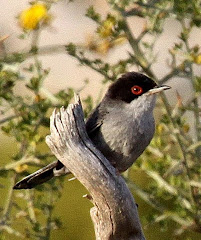The peninsula at Cape Greco is important for migrants (see earlier), the low-lying, rocky terrain and scattered scrub acting as a haven for incoming birds. In one area where the vegetation was somewhat taller a very handsome Woodchat Shrike had staked out a feeding territory.

Although elusive at first, with patience it was possible to approach quite closely using intervening bushes as cover and eventually to within 25 metres giving good views as it frequently dropped from its perch to pounce on prey below. Even so, it was clearly aware of my presence and kept a wary eye on me by frequently looking back over its shoulder. Like most Shrikes it had selected prominent perches on small sparsely-vegetated trees. It appeared to have just three of these, seemingly moving around them at random. From its head patterning it appeared to be a male.


On returning the following day there was no sign of the bird, it presumably having moved further along its journey. Its destination would probably be mainland Europe since Woodchats only rarely nest in Cyprus.

[The rough scrubby garrigue favoured by the Shrike]



















































.jpg)



